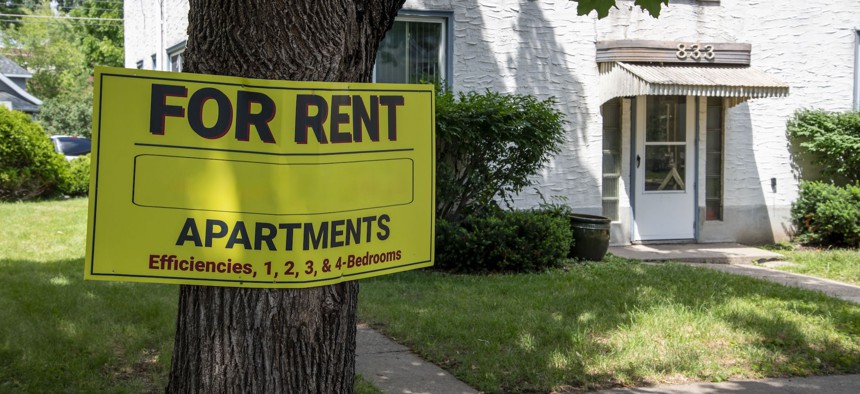Rent growth cools, but affordability is still out of reach

Michael Siluk/UCG/Universal Images Group via Getty Images
Even though rents aren’t rising as quickly as they were last year, they’re still too damn high for an increasing number of households.
There’s some good news for renters in 2024: Rent growth is slowing significantly, meaning fewer tenants are seeing large increases in their housing costs.
Rent increases reached historic highs in 2021 and 2022, but began to decrease rapidly in the latter half of 2023, according to a new report on rental housing from Harvard University’s Joint Center for Housing Studies. In early 2022, rent growth peaked at 15%, but in the third quarter of 2023 dropped to just 0.4%. More units have come online in recent years and apartment vacancy hit 6.6% in the third quarter of last year, up from 5.6% in early 2021.
The bad news? Just about everything else.
“Rental markets are softening but affordability conditions are worse than ever before,” said Senior Research Associate Whitney Airgood-Obrycki during the report’s release event Thursday.
The report found that nearly half of tenants were cost-burdened in 2022, meaning they spent 30% or more of their income on rent. In many of those households, housing costs ate up at least 50% of incomes.
The number of cost-burdened middle-income households earning between $45,000 and $74,999 has increased 5.4% since 2019, the largest expansion of any economic bracket. Low-income renters are still the most widely impacted, with a record high 83% of households being cost-burdened.
Without action, people who had trouble paying rent in 2022 will continue to struggle to cover housing costs, Airgood-Obrycki said. Even while rents are no longer increasing, rising operating costs and high-interest rates are partly behind continued high rents, the report said. And while there’s been an uptick in construction, many of the new units coming online are for high-income households. When it comes to affordable housing, there's been a net loss of 2.1 million units since 2012 for households earning less than $24,000 a year.
And it’s just about impossible to discuss affordability without mentioning the classic problem of rents outpacing wages. Median rents in 2022 were 21% higher than in 2001, while renters’ earnings increased just 2% during the same period. Plus, pandemic relief programs—including eviction moratoriums and emergency rental assistance—have mostly ended, and evictions and homelessness are rising, Airgood-Obrycki said.
Another complication to balancing affordable rental supply and demand is that the existing rental stock will also require significant investments for updates and repairs, the report said. Nearly four million households—or about 8% of renters—live in sub-par units with issues like structural deficiencies or inconsistent heat, water and electricity. Last year, the Federal Reserve Bank of Philadelphia estimated it would cost $51.5 billion to address the inadequacies of the country’s occupied rental units. That doesn’t include updates needed to meet the accessibility needs of the rapidly aging population or the resiliency needs of communities in areas most susceptible to climate change’s impacts.
“Making all of these needed improvements in a way that also preserves affordability will be increasingly challenging for property owners, as costs such as insurance are increasing, and those returns [on the property] are slowing,” she said.
While an increase in new multifamily construction looked like a bright spot in 2022 and in early 2023, it has dropped off over the last several months, falling 30% year-over-year in October. The cooling market and high costs of financing have deterred investors and builders, Airgood-Obrycki said.
But there is movement to address the issue at every level of government. More people are talking about the affordable housing crisis, and there’s pressure on state and local leaders to implement policies to spur development.
“The issue of housing affordability is no longer a problem just the poor,” said Chris Herbert, managing director of the Harvard Joint Center for Housing Studies, adding that “democratization of the problem helps” get more people on board with policies to spur development. State mandates and preemption laws can help.
Herbert pointed to Massachusetts, where a new law requires that communities served by state transit must allow increased housing density in certain areas. “They say to the localities, not that ‘thou can’ but ‘thou shalt’ do this,” he said.
Compelling neighborhoods to increase housing density has activated advocates who say “yes” to broader housing reform.
“I think what it's done is it's really empowered the YIMBYs,” Herbert said. “Whereas before, when it's on a case-by-case basis, and it's always going to promote this specific development and the neighbors come out in opposition to it.”
But to update local zoning codes and rehabilitate aging housing stock will require significant resources. The U.S. Department of Housing and Urban Development is working on that, said Ethan Handelman, the agency’s deputy assistant secretary for multifamily.
“The Biden Harris administration has a Housing Supply Action Plan, which uses all of the tools available to us and asks for more because we know we need more,” he said. Included in the president’s budget proposal, for example, is increased funding for rental assistance because only one in four eligible households currently receive the benefit.
“Social Security is an entitlement. Medicare is an entitlement. Housing assistance ain't—it's a lottery, and it shouldn't be,” Handelman said.
But until new resources and policies come to fruition to boost the housing stock, the rental landscape will continue to be grim.
“Greater policy efforts are going to be needed,” Airgood-Obrycki said. “They're going to be crucial for meeting the deep affordability needs that exist across the country.”






